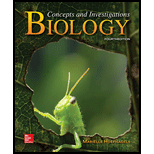
Concept explainers
Which of the following is NOT a similarity between land plants and green algae?
- a. Photosynthesis
- b. Starch as a storage form of energy
- c. Cellulose cell walls
- d. The presence of a cuticle and stomata
Introduction:
Green algae are the closest relatives of plants, some plants are also called charophytes. Both share most of the common features, they both are multicellular, they have cellulose cell wall and show photosynthesis.
Answer to Problem 1MCQ
Correct answer:
The stomata and cuticle are the adaptions of plants. Therefore, option d. is correct.
Explanation of Solution
Reason for the correct statement:
The plants can obtain and conserve resources by the stomata and cuticle. Plants can exchange gases through stomata. A cuticle is a lining of wax which makes water and gases impermeable to leaves. So, both stomata and cuticle are not present in green algae; they have cellulose and photosynthetic pigments.
Option d. is given as “The presence of a cuticle and stomata”.
As, “The presence of a cuticle and stomata is not a similarity between land plants and green algae”, is the right answer.
Hence, the option d. is correct.
Reasons for the incorrect statements:
Option a. is given as “Photosynthesis”.
The plants carry photosynthesis with the help of photosynthetic pigments CO2, water and minerals. The same photosynthetic pigments are present in green algae. This answer does not support the statement. So, it is a wrong answer.
Option b. is given as “Starch as a storage form of energy”.
Starch is present in both plants as well as in green algae and used as a nutrient reserve. This answer does not support the statement. So, it is a wrong answer.
Option c. is given as “Cellulose cell walls”.
The cellulose-rich cell walls are present in both green algae as well as in land plants. This answer does not support the statement. So, it is a wrong answer.
Hence, options a., b., and c. are incorrect.
The stomata and cuticle waxy linings are only present in land plants. The stomata opening is for the respiration and cuticle is an adaption in plants to protect the plant from water.
Want to see more full solutions like this?
Chapter 19 Solutions
Biology: Concepts and Investigations
Additional Science Textbook Solutions
Chemistry
Genetics: From Genes to Genomes
Chemistry: An Introduction to General, Organic, and Biological Chemistry (13th Edition)
Campbell Essential Biology (7th Edition)
- Amino Acid Coclow TABle 3' Gly Phe Leu (G) (F) (L) 3- Val (V) Arg (R) Ser (S) Ala (A) Lys (K) CAG G Glu Asp (E) (D) Ser (S) CCCAGUCAGUCAGUCAG 0204 C U A G C Asn (N) G 4 A AGU C GU (5) AC C UGA A G5 C CUGACUGACUGACUGAC Thr (T) Met (M) lle £€ (1) U 4 G Tyr Σε (Y) U Cys (C) C A G Trp (W) 3' U C A Leu בוט His Pro (P) ££ (H) Gin (Q) Arg 흐름 (R) (L) Start Stop 8. Transcription and Translation Practice: (Video 10-1 and 10-2) A. Below is the sense strand of a DNA gene. Using the sense strand, create the antisense DNA strand and label the 5' and 3' ends. B. Use the antisense strand that you create in part A as a template to create the mRNA transcript of the gene and label the 5' and 3' ends. C. Translate the mRNA you produced in part B into the polypeptide sequence making sure to follow all the rules of translation. 5'-AGCATGACTAATAGTTGTTGAGCTGTC-3' (sense strand) 4arrow_forwardWhat is the structure and function of Eukaryotic cells, including their organelles? How are Eukaryotic cells different than Prokaryotic cells, in terms of evolution which form of the cell might have came first? How do Eukaryotic cells become malignant (cancerous)?arrow_forwardWhat are the roles of DNA and proteins inside of the cell? What are the building blocks or molecular components of the DNA and proteins? How are proteins produced within the cell? What connection is there between DNA, proteins, and the cell cycle? What is the relationship between DNA, proteins, and Cancer?arrow_forward
- please fill in the empty sports, thank you!arrow_forwardIn one paragraph show how atoms and they're structure are related to the structure of dna and proteins. Talk about what atoms are. what they're made of, why chemical bonding is important to DNA?arrow_forwardWhat are the structure and properties of atoms and chemical bonds (especially how they relate to DNA and proteins).arrow_forward
- The Sentinel Cell: Nature’s Answer to Cancer?arrow_forwardMolecular Biology Question You are working to characterize a novel protein in mice. Analysis shows that high levels of the primary transcript that codes for this protein are found in tissue from the brain, muscle, liver, and pancreas. However, an antibody that recognizes the C-terminal portion of the protein indicates that the protein is present in brain, muscle, and liver, but not in the pancreas. What is the most likely explanation for this result?arrow_forwardMolecular Biology Explain/discuss how “slow stop” and “quick/fast stop” mutants wereused to identify different protein involved in DNA replication in E. coli.arrow_forward
 Concepts of BiologyBiologyISBN:9781938168116Author:Samantha Fowler, Rebecca Roush, James WisePublisher:OpenStax College
Concepts of BiologyBiologyISBN:9781938168116Author:Samantha Fowler, Rebecca Roush, James WisePublisher:OpenStax College Biology (MindTap Course List)BiologyISBN:9781337392938Author:Eldra Solomon, Charles Martin, Diana W. Martin, Linda R. BergPublisher:Cengage Learning
Biology (MindTap Course List)BiologyISBN:9781337392938Author:Eldra Solomon, Charles Martin, Diana W. Martin, Linda R. BergPublisher:Cengage Learning
 Biology: The Dynamic Science (MindTap Course List)BiologyISBN:9781305389892Author:Peter J. Russell, Paul E. Hertz, Beverly McMillanPublisher:Cengage Learning
Biology: The Dynamic Science (MindTap Course List)BiologyISBN:9781305389892Author:Peter J. Russell, Paul E. Hertz, Beverly McMillanPublisher:Cengage Learning Biology 2eBiologyISBN:9781947172517Author:Matthew Douglas, Jung Choi, Mary Ann ClarkPublisher:OpenStax
Biology 2eBiologyISBN:9781947172517Author:Matthew Douglas, Jung Choi, Mary Ann ClarkPublisher:OpenStax





